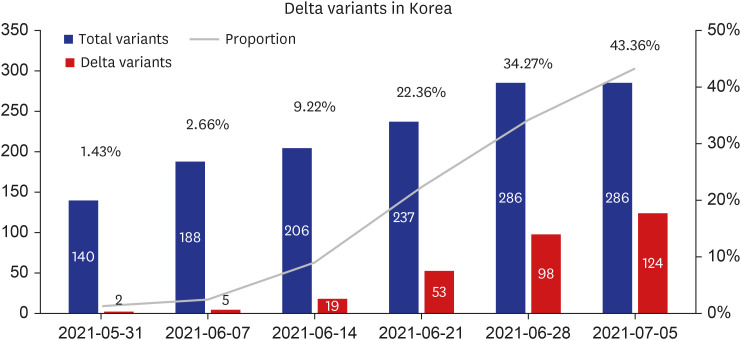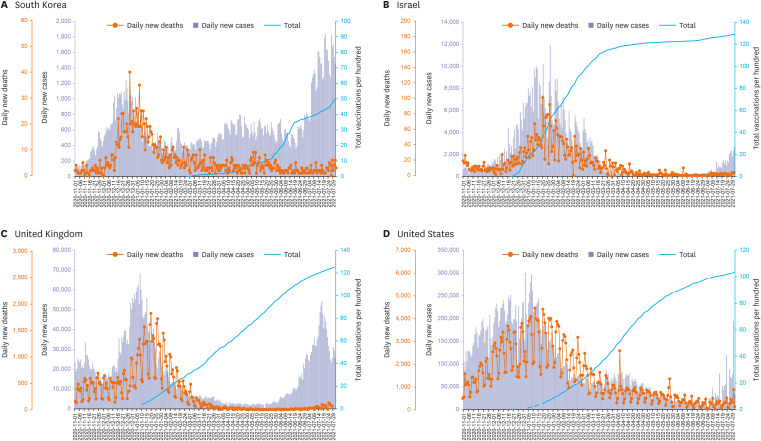The coronavirus disease 2019 (COVID-19) pandemic was challenging in July 2021. As the number of confirmed cases increased sharply, the planned easing of social distancing reached an apex. Moreover, the delta variant has become the most dominant strain in Korea (Fig. 1).1 Unlike the past three waves, the number of deaths and critically ill patients has not sharply increased despite the rapid spread of the delta variant (Fig. 2).2 This phenomenon has been observed in most countries with high vaccination rates and may provide a new perspective on COVID-19.
Coexistence with COVID-19 has been proposed in the United Kingdom (UK) and Singapore, but their strategies differ significantly. The UK declared “freedom day” on July 19 and lifted most lockdown restrictions.3 Singapore, meanwhile, has proposed a gradual easing of lockdown measures while treating COVID-19 as an endemic disease, but the schedule has been delayed due to the resurgence of the delta variant.4
We have accumulated considerable knowledge on COVID-19. First, there is an apparent high-risk group for COVID-19. The mortality rate changes rapidly with age and underlying disease. Therefore, the use of vaccines to protect high-risk groups can minimize damage. Second, the variants of concern have emerged, the effectiveness of vaccines to prevent infection is gradually decreasing. However, the clinical effect of preventing severe cases and deaths is stably maintained at a high level. Third, non-pharmaceutical interventions, such as social distancing, lockdown, epidemiological investigations, and diagnostic tests, have been effective but challenging to maintain because of the substantial socio-economic losses. Lastly, the basic reproduction number of the delta variant has risen to a level where it is challenging to form herd immunity with vaccination-only.
Therefore, COVID-19 will not easily disappear. It will survive and threaten us for several generations. It can be temporarily controlled, but multiple variants will persistently emerge and periodically be imported. Even if the 70% level of herd immunity suggested by the Korean government is reached, it will be difficult to control the pandemic completely. The pandemic will not end clearly like the end of a war; it will just slowly be considered insignificant.
No solution will satisfy everyone. The side effects of preventive measures have affected the self-employed and small businesses, and ensuring society's safety can be a serious threat to some people's survival. With the delayed social distancing reorganization plan, many people have become impatient. Preventive measures can and should be flexible depending on the situation. There is no ideal end to the pandemic; therefore, social consensus on the timing and plan for its future is necessary.
Experts consider that the pandemic will begin to end once high-risk groups are entirely protected. Furthermore, clear definitions of high-risk groups and the completion of protection are needed. People aged > 50 years can be considered the standard high-risk group. If a large outbreak affects them, critically ill patients increase, possibly becoming a social risk. It is necessary to protect this group as they are socially active, have a high risk of infection, and have fatality and high severity rates of 0.3% and 1.5%, respectively.5 Even people aged < 50 years should be protected if they have underlying diseases, such as diabetes and chronic kidney disease.6 Considering the vaccine efficacy in Korea and the prevalence of the delta variant, it is difficult to regard single-dose vaccination as “complete protection.” It is necessary to receive two doses to achieve > 90% preventive effects in disease severity.
The sustainability of preventive measures should also be considered. The current situation, in which the relaxation of preventive measures was hastily proposed but then canceled in favor of extending the existing measures by two weeks, exhausts people. Staggered ease of preventative measures could prevent this. It is also necessary to consider the following steps after vaccinating high-risk groups. A return to the past will not occur quickly, and numerous controversies and resurgences may arise. The continuation of the costly preventive measures should be discussed. Furthermore, we need to review whether measures, such as self-quarantine, blocking inflow from foreign countries, epidemiological investigations, and large-scale tests, are needed.
We also need to prepare the future countermeasures to be implemented to live with COVID-19.
In addition to booster vaccination, the medical system and resources necessary for coexistence with COVID-19 must be prepared by the second half of this year. The battle will not end easily.
References
1. CoVariants. Overview of Variants in Countries. Updated 2021. Accessed July 4, 2017. https://covariants.org/per-country.
2. Our world in Data. Coronavirus (COVID-19) Vaccinations. Updated 2021. Accessed August 2, 2021. https://ourworldindata.org/covid-vaccinations.
3. BBC news. Covid: England lockdown rules to end on 19 July, PM confirms. Updated 2021. Accessed July 12, 2021. https://www.bbc.com/news/uk-57809691.
4. The Straits Times. Singapore to tighten Covid-19 measures from July 19: What you need to know. Updated 2021. Accessed July 16, 2021. https://www.straitstimes.com/singapore/health/singapores-covid-19-measures-from-july-19-7-things-you-need-to-know.
5. Lee Y, Jung J. Potential benefits and harms of the Astra-Zeneca Covid-19 vaccine. Public Health Wkly Rep. 2021; 14(17):988–996.
6. Ji W, Huh K, Kang M, Hong J, Bae GH, Lee R, et al. Effect of underlying comorbidities on the infection and severity of COVID-19 in Korea: a nationwide case-control study. J Korean Med Sci. 2020; 35(25):e237. PMID: 32597048.

Go to : 




 PDF
PDF Citation
Citation Print
Print





 XML Download
XML Download